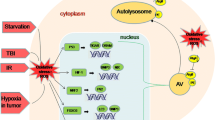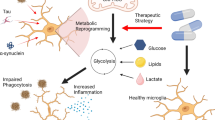Abstract
An elevated level of glucose has been found in the blood of hyperglycemia and diabetes patients associated with several central nervous system (CNS) complications. These disorders may be due to the up-regulation of many neurotoxic mediators by host cells triggered by high glucose (HG). Moreover, increased plasma levels of matrix metalloproteinases (MMPs), MMP-9 especially, have been observed in patients with brain injuries and may contribute to brain diseases. However, the HG level triggers the CNS pathological responses during the hyperglycemia and diabetes remain unclear. In this study, we use a transformed astroglial cell (RBA-1) as a model to investigate the signaling mechanisms of MMP-9 induction by HG and its effects on neuronal cells. First, the data by gelatin zymographic and Western blotting analyses demonstrated that HG-induced MMP-9 expression. Next, the data obtained with selective pharmacological inhibitors and small interfering RNAs showed that HG-induced MMP-9 expression via a c-Src-dependent transactivation of platelet-derived growth factor receptor and PI3K/Akt linking to NADPH oxidase 2-derived reactive oxygen species signal and activation of MAPKs. Subsequently, the transcriptional factor AP-1 was activated and thereby turned on transcription of MMP-9 gene. Ultimately, we found that HG-induced MMP-9 expression from astrocytes resulted in neuronal apoptosis. These results will provide new insights into the mechanisms and effects of the action of HG, supporting the hypothesis that HG may cause brain disorders in the development of diabetes and hyperglycemia-induced CNS complications such as neurodegenerative diseases.








Similar content being viewed by others
References
Tomlinson DR, Gardiner NJ (2008) Glucose neurotoxicity. Nat Rev Neurosci 9:36–45
Massengale JL, Gasche Y, Chan PH (2002) Carbohydrate source influences gelatinase production by mouse astrocytes in vitro. Glia 38:240–245
Chen J, Cui X, Zacharek A, Cui Y, Roberts C, Chopp M (2011) White matter damage and the effect of matrix metalloproteinases in type 2 diabetic mice after stroke. Stroke 42:445–452
Llewelyn JG (2003) The diabetic neuropathies: types, diagnosis and management. J Neurol Neurosurg Psychiatry 74(Suppl 2):ii15–ii19
Archer AG, Watkins PJ, Thomas PK, Sharma AK, Payan J (1983) The natural history of acute painful neuropathy in diabetes mellitus. J Neurol Neurosurg Psychiatry 46:491–499
Sima AA, Bril V, Nathaniel V, McEwen TA, Brown MB, Lattimer SA, Greene DA (1988) Regeneration and repair of myelinated fibers in sural-nerve biopsy specimens from patients with diabetic neuropathy treated with sorbinil. New Engl J Med 319:548–555
Kimelberg HK (1995) Receptors on astrocytes—what possible functions? Neurochem Int 26:27–40
Levinson SW, Goldman JE (1993) Astrocyte origins. In: Murphy S (ed) Astrocytes: pharmacology and function. Academic Press, San Diego, pp 1–22
Hamby ME, Sofroniew MV (2010) Reactive astrocytes as therapeutic targets for CNS disorders. Neurotherapeutics 7:494–506
Zhao Y, Rempe DA (2010) Targeting astrocytes for stroke therapy. Neurotherapeutics 7:439–451
Verkhratsky A, Olabarria M, Noristani HN, Yeh CY, Rodriguez JJ (2010) Astrocytes in Alzheimer’s disease. Neurotherapeutics 7:399–412
Yang CM, Hsieh HL, Lin CC, Shih RH, Chi PL, Cheng SE, Hsiao LD (2013) Multiple factors from bradykinin-challenged astrocytes contribute to the neuronal apoptosis: involvement of astroglial ROS, MMP-9, and HO-1/CO system. Mol Neurobiol 47:1020–1033
Stamenkovic I (2003) Extracellular matrix remodelling: the role of matrix metalloproteinases. J Pathol 200:448–464
Yong VW, Power C, Forsyth P, Edwards DR (2001) Metalloproteinases in biology and pathology of the nervous system. Nat Rev Neurosci 2:502–511
Gottschall PE, Yu X (1995) Cytokines regulate gelatinase A, B (matrix metalloproteinase 2 and 9) activity in cultured rat astrocytes. J Neurochem 64:1513–1520
Chan PH (2001) Reactive oxygen radicals in signaling and damage in the ischemic brain. J Cereb Blood Flow Metab 21:2–14
Chrissobolis S, Faraci FM (2008) The role of oxidative stress and NADPH oxidase in cerebrovascular disease. Trends Mol Med 14:495–502
Halliwell B (2006) Oxidative stress and neurodegeneration: where are we now? J Neurochem 97:1634–1658
Wang J, Li G, Wang Z, Zhang X, Yao L, Wang F, Liu S, Yin J, Ling EA, Wang L, Hao A (2012) High glucose-induced expression of inflammatory cytokines and reactive oxygen species in cultured astrocytes. Neuroscience 202:58–68
Wei W, Liu Q, Tan Y, Liu L, Li X, Cai L (2009) Oxidative stress, diabetes, and diabetic complications. Hemoglobin 33:370–377
Shanmugam N, Reddy MA, Guha M, Natarajan R (2003) High glucose-induced expression of proinflammatory cytokine and chemokine genes in monocytic cells. Diabetes 52:1256–1264
Nishikawa T, Araki E (2007) Impact of mitochondrial ROS production in the pathogenesis of diabetes mellitus and its complications. Antioxid Redox Signal 9:343–353
Jou TC, Jou MJ, Chen JY, Lee SY (1985) Properties of rat brain astrocytes in long-term culture. Taiwan Yi Xue Hui Za Zhi 84:865–881
Hsieh HL, Yen MH, Jou MJ, Yang CM (2004) Intracellular signalings underlying bradykinin-induced matrix metalloproteinase-9 expression in rat brain astrocyte-1. Cell Signal 16:1163–1176
Tung WH, Hsieh HL, Yang CM (2010) Enterovirus 71 induces COX-2 expression via MAPKs, NF-κB, and AP-1 in SK-N-SH cells: role of PGE2 in viral replication. Cell Signal 22:234–246
LeBel CP, Ischiropoulos H, Bondy SC (1992) Evaluation of the probe 2′,7′-dichlorofluorescin as an indicator of reactive oxygen species formation and oxidative stress. Chem Res Toxicol 5:227–231
Reinehr R, Görg B, Becker S, Qvartskhava N, Bidmon HJ, Selbach O, Haas HL, Schliess F, Häussinger D (2007) Hypoosmotic swelling and ammonia increase oxidative stress by NADPH oxidase in cultured astrocytes and vital brain slices. Glia 55:758–771
Hsieh HL, Wu CY, Yang CM (2008) Bradykinin induces matrix metalloproteinase-9 expression and cell migration through a PKC-δ-dependent ERK/Elk-1 pathway in astrocytes. Glia 56:619–632
Hsieh HL, Wang HH, Wu CY, Tung WH, Yang CM (2010) Lipoteichoic acid induces matrix metalloproteinase-9 expression via transactivation of PDGF receptors and NF-κB activation in rat brain astrocytes. Neurotox Res 17:344–359
Wang HH, Hsieh HL, Yang CM (2010) Calmodulin kinase II-dependent transactivation of PDGF receptors mediates astrocytic MMP-9 expression and cell motility induced by lipoteichoic acid. J Neuroinflammation 7:84
Wu CY, Hsieh HL, Sun CC, Tseng CP, Yang CM (2008) IL-1β induces proMMP-9 expression via c-Src-dependent PDGFR/PI3K/Akt/p300 cascade in rat brain astrocytes. J Neurochem 105:1499–14512
Infanger DW, Sharma RV, Davisson RL (2006) NADPH oxidases of the brain: distribution, regulation, and function. Antioxid Redox Signal 8:1583–1596
Bedard K, Krause KH (2007) The NOX family of ROS-generating NADPH oxidases: physiology and pathophysiology. Physiol Rev 87:245–313
Hsieh HL, Lin CC, Shih RH, Hsiao LD, Yang CM (2012) NADPH oxidase-mediated redox signal contributes to lipoteichoic acid-induced MMP-9 upregulation in brain astrocytes. J Neuroinflammation 9:110
Lin CC, Hsieh HL, Shih RH, Chi PL, Cheng SE, Chen JC, Yang CM (2012) NADPH oxidase 2-derived reactive oxygen species signal contributes to bradykinin-induced matrix metalloproteinase-9 expression and cell migration in brain astrocytes. Cell Commun Signal 10:35
Hsieh HL, Wang HH, Wu WB, Chu PJ, Yang CM (2010) Transforming growth factor-β1 induces matrix metalloproteinase-9 and cell migration in astrocytes: roles of ROS-dependent ERK- and JNK-NF-κB pathways. J Neuroinflammation 7:88
Ralay Ranaivo H, Hodge JN, Choi N, Wainwright MS (2012) Albumin induces upregulation of matrix metalloproteinase-9 in astrocytes via MAPK and reactive oxygen species-dependent pathways. J Neuroinflammation 9:68
Wang HH, Hsieh HL, Wu CY, Sun CC, Yang CM (2009) Oxidized low-density lipoprotein induces matrix metalloproteinase-9 expression via a p42/p44 and JNK-dependent AP-1 pathway in brain astrocytes. Glia 57:24–38
Rosenberg GA (2002) Matrix metalloproteinases in neuroinflammation. Glia 39:279–291
Glass CK, Saijo K, Winner B, Marchetto MC, Gage FH (2010) Mechanisms underlying inflammation in neurodegeneration. Cell 140:918–934
Floyd RA (1999) Neuroinflammatory processes are important in neurodegenerative diseases: an hypothesis to explain the increased formation of reactive oxygen and nitrogen species as major factors involved in neurodegenerative disease development. Free Radic Biol Med 26:1346–1355
Wyss-Coray T (2006) Inflammation in Alzheimer disease: driving force, bystander or beneficial response? Nat Med 12:1005–1015
Abramov AY, Jacobson J, Wientjes F, Hothersall J, Canevari L, Duchen MRL (2005) Expression and modulation of an NADPH oxidase in mammalian astrocytes. J Neurosci 25:9176–9184
Hsieh HL, Wang HH, Wu CY, Yang CM (2010) Reactive oxygen species-dependent c-Fos/activator protein 1 induction upregulates heme oxygenase-1 expression by bradykinin in brain astrocytes. Antioxid Redox Signal 13:1829–1844
Kim SY, Lee JG, Cho WS, Cho KH, Sakong J, Kim JR, Chin BR, Baek SH (2010) Role of NADPH oxidase-2 in lipopolysaccharide-induced matrix metalloproteinase expression and cell migration. Immunol Cell Biol 88:197–204
Kyriakis JM, Avruch J (2001) Mammalian mitogen-activated protein kinase signal transduction pathways activated by stress and inflammation. Physiol Rev 81:807–869
Kar S, Subbaram S, Carrico PM, Melendez JA (2010) Redox-control of matrix metalloproteinase-1: a critical link between free radicals, matrix remodeling and degenerative disease. Respir Physiol Neurobiol 174:299–306
Lopes JP, Oliveira SM, Soares Fortunato J (2008) Oxidative stress and its effects on insulin resistance and pancreatic beta-cells dysfunction: relationship with type 2 diabetes mellitus complications. Acta Med Port 21:293–302
Wu WS (2006) The signaling mechanism of ROS in tumor progression. Cancer Metastasis Rev 25:695–705
Hsieh HL, Lin CC, Hsiao LD, Yang CM (2013) High glucose induces reactive oxygen species-dependent matrix metalloproteinase-9 expression and cell migration in brain astrocytes. Mol Neurobiol 48:601–614
Kennedy KA, Sandiford SD, Skerjanc IS, Li SS (2012) Reactive oxygen species and the neuronal fate. Cell Mol Life Sci 69:215–221
Sen CK, Packer L (1996) Antioxidant and redox regulation of gene transcription. FASEB J 10:709–720
Woo CH, Lim JH, Kim JH (2004) Lipopolysaccharide induces matrix metalloproteinase-9 expression via a mitochondrial reactive oxygen species-p38 kinase-activator protein-1 pathway in Raw 264.7 cells. J Immunol 173:6973–6980
Byun HJ, Hong IK, Kim E, Jin YJ, Jeoung DI, Hahn JH, Kim YM, Park SH, Lee H (2006) A splice variant of CD99 increases motility and MMP-9 expression of human breast cancer cells through the AKT-, ERK-, and JNK-dependent AP-1 activation signaling pathways. J Biol Chem 281:34833–34847
Baydas G, Reiter RJ, Yasar A, Tuzcu M, Akdemir I, Nedzvetskii VS (2003) Melatonin reduces glial reactivity in the hippocampus, cortex, and cerebellum of streptozotocin-induced diabetic rats. Free Radic Biol Med 35:797–804
Li H, Mittal A, Paul PK, Kumar M, Srivastava DS, Tyagi SC, Kumar A (2009) Tumor necrosis factor-related weak inducer of apoptosis augments matrix metalloproteinase 9 (MMP-9) production in skeletal muscle through the activation of nuclear factor-κB-inducing kinase and p38 mitogen-activated protein kinase: a potential role of MMP-9 in myopathy. J Biol Chem 284:4439–4450
Acknowledgments
This work was supported by the Ministry of Education, Taiwan, grant number: EMRPD1D0231 and EMRPD1D0241; National Science Council, Taiwan, grant number: NSC102-2321-B-182-011, NSC101-2320-B-182-039-MY3, and NSC102-2320-B-255-005-MY3; Chang Gung Medical Research Foundation, grant number: CMRPD1B0382, CMRPD1C0101, CMRPD1C0561, CMRPF1A0063, CMRPG5C0061, CMRPG391033, and CMRPG3B1092.
Conflict of Interest
None.
Author information
Authors and Affiliations
Corresponding author
Rights and permissions
About this article
Cite this article
Hsieh, HL., Chi, PL., Lin, CC. et al. Up-regulation of ROS-Dependent Matrix Metalloproteinase-9 from High-Glucose-Challenged Astrocytes Contributes to the Neuronal Apoptosis. Mol Neurobiol 50, 520–533 (2014). https://doi.org/10.1007/s12035-013-8628-y
Received:
Accepted:
Published:
Issue Date:
DOI: https://doi.org/10.1007/s12035-013-8628-y




